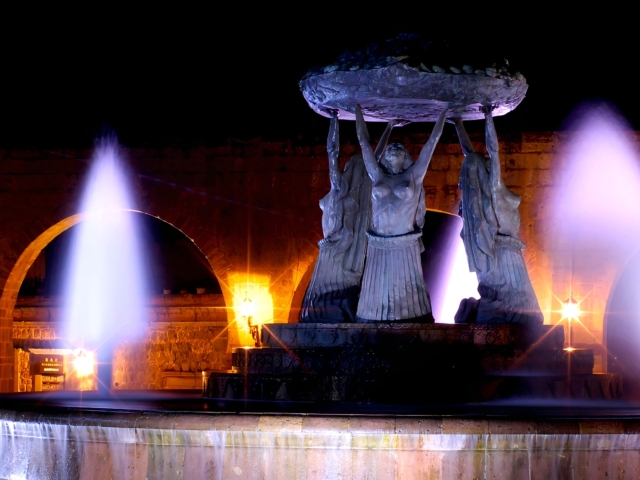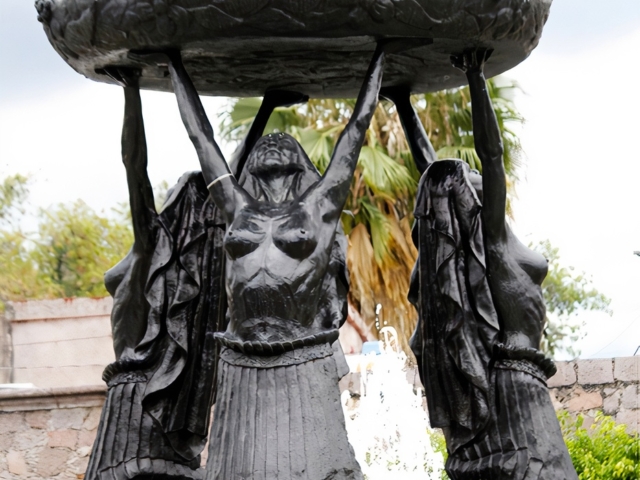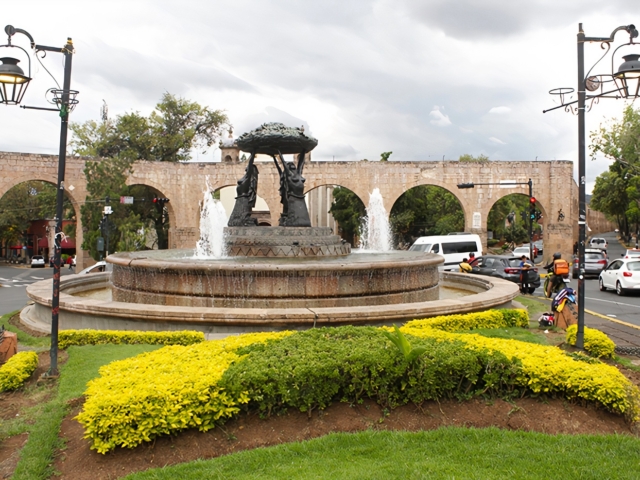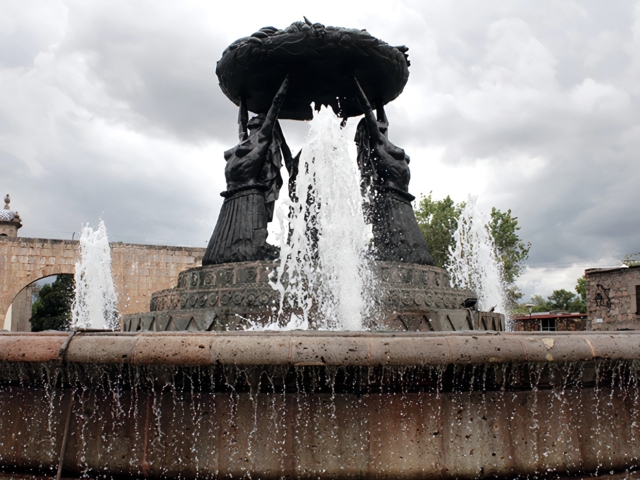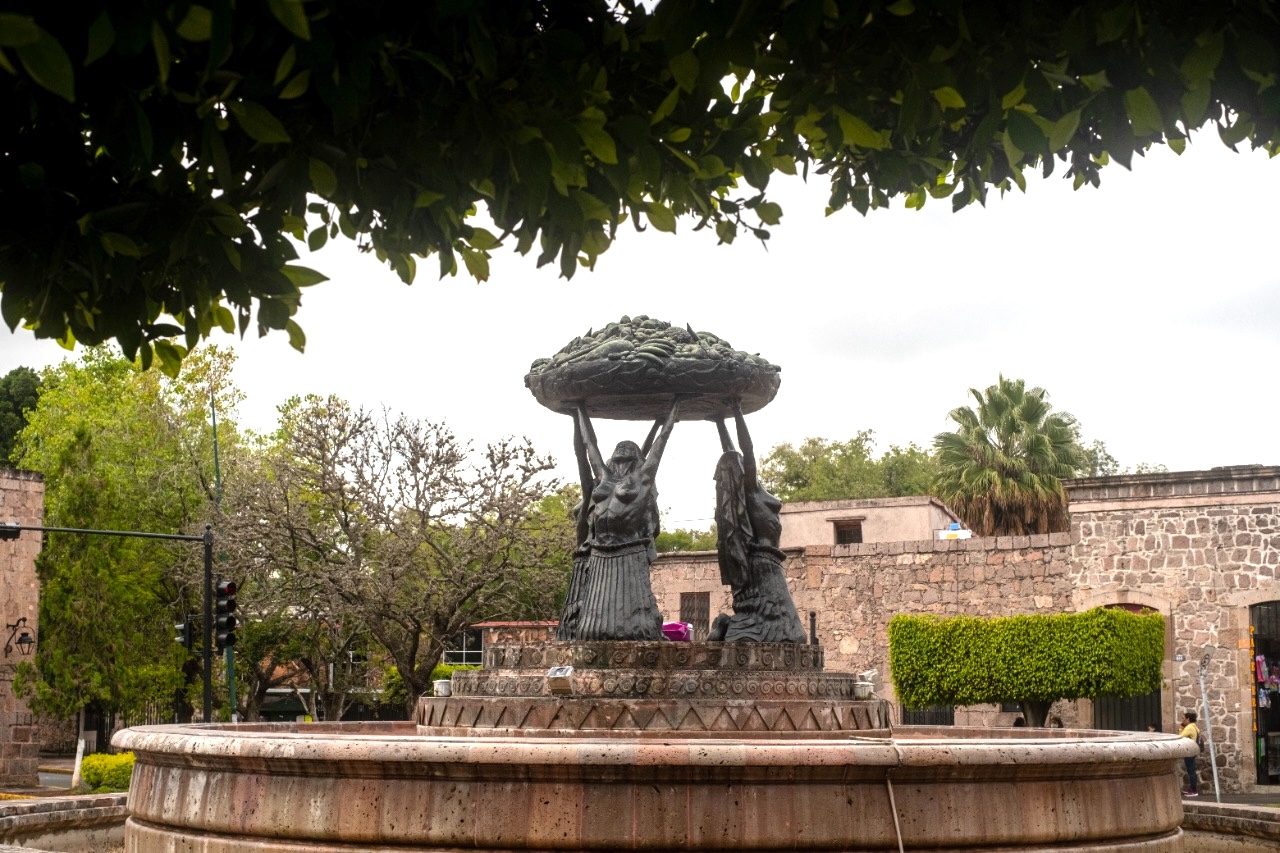
Adress
Av. Acueducto 890, Centro, 58000 Morelia, Michoacán, México.
GPS
19.702849563697, -101.1824297905
KNOW MORE PLACES
VISITA OTRAS LOCALIDADES
The Tarascas fountain, originally called Las Indias, is located at the intersection of the current Av. Acueducto and Av. Francisco I. Madero Oriente, right in front of one of the final segments of the Roman ashlar aqueduct of the city of Morelia, formerly Valladolid.
The Acueducto Avenue used to be the road to the Hacienda del Rincón, where the original Pirinda indigenous nucleus of Guayangareo was located. The first Spaniard who inhabited the Guayangareo valley, the Sevillian Gonzalo Gómez, settled on that site. The current Lourdes chapel was known as the Chapel of Our Lord of Rincón until the end of the 19th century, due to its relationship with the hacienda.
Francisco I. Madero Oriente Avenue, which from this section to the exit to Charo is called Calzada Madero, was formerly the road to Mexico City, via Charo-Indaparapeo-Queréndaro-Zinapécuaro-Maravatío. With some changes, this was the route since pre-Hispanic times.
Later, when the route to Mexico City via Mil Cumbres was opened, Avenida Acueducto was the most used route to get from the capital to Morelia. Towards the 1950s, the eastern part of the city was not very developed, so the city was best seen near the Cuauhtémoc Forest and the Morelos Garden.
During the colonial era, the section of Avenida Madero that runs between the Villalongín garden and the Tarascas fountain was part of Calle Real, that is, the main street of the city. Even so, several 19th-century authors mentioned the area between Calle Real, the current Aquiles Serdán street and Manuel Villalongín street, as part of the Plazuela de Ánimas.
The main area of this plaza would be the current polygon of the Villalongín Garden, which from 1750 to 1850 approximately, housed the Capilla de Ánimas, which was demolished to build the city's poorhouse. The plaza remained unused, with only a fountain in the eastern part, until the governorship of Mariano Jiménez, the Oaxacan military man who beautified the city. The garden was built in 1889, and the fountain that was originally in the Plaza de los Mártires was placed there, and in its center a pedestal with a bronze sculpture of a naiad or water nymph.
Aesthetically, the site without the fountain harmonized with the architecture of the Calzada Fray Antonio de San Miguel, the Chapel of Lourdes, the Aqueduct and the Manuel Villalongín Garden, by allowing a view of all these places without horizontal or vertical interruption.
Design, construction and materials
The Tarascas fountain was designed by the artist Antonio Silva Díaz, sculpted by Benigno Lara and placed on its pedestal around October 1931. It was cast with brick gravel, cement and iron rods brought from the United States or Europe (at that time there were no nationally manufactured rods).
Authority that promoted its construction
El Mayor Rafael Miguel Pedrajo Barrios, nació en San Luis Potosí hacia 1896, falleció en la ciudad de México en 1982. Llevó a cabo sus primeros estudios en San Luis Potosí, luego la carrera castrense en el Heroico Colegio Militar. Al concluir sus estudios fue enviado a Morelia, donde conocería al General Lázaro Cárdenas. Al concluir la revolución mexicana, fungió como jefe de tránsito del Distrito Federal, y luego presidente municipal de Morelia, Mich. (1930-1931). Notoriamente, fue secretario particular del General Lázaro Cárdenas del Río. Posteriormente sería gobernador de Baja California Sur, luego jefe de aduanas en Laredo, Tamaulipas y por último fue el encargado de reorganizar las islas Marías y dotarlas de equipamiento. Fue nombrado hombre ilustre en Tamaulipas.
The meaning of the fountain
The original meaning of the fountain is unknown. In the absence of an opinion from the designer (Antonio Silva Díaz), the sculptor (Benigno Lara) and the promoter (Rafael Pedrajo), one can only speculate. In fact, they officially have no name, and when they were first installed they were called “Fountain of the Indies”; due to the fact that Morelia is the capital of the state of Michoacán, and because this is the P’urhépecha territory par excellence, the sculpture was called “Fountain of the Tarascas”. Tarascan is the name given to the P’urhépecha people, according to Fray Bernardino de Sahagún and Pedro Ponce de León, because they were followers of a very ancient god called Taras (Thares means ancient).
Según la Relación de Michoacán, los P’urhépecha llamaban Tarhaskua a los españoles, por el hecho de darles a sus parientes hembras a los conquistadores. Tarhaskua significa cuñado, pero no es el nombre que los michoacanos admiten como gentilicio, ellos se autodenominan P’urhépecha que quiere decir GENTE o PERSONAS. Cualquier significado que actualmente se le reconoce a la escultura (tres princesas P’urhépechas, las tres capitales del imperio P’urhépecha, las tres capitales de la provincia de Michoacán, y un largo etcétera) es totalmente subjetivo y no tiene sustento en ningún documento conocido, mucho menos en alguna inscripción o placa en cualquiera de las dos fuentes que existen.
The engineer Manuel Rodríguez Morales has speculated that at the beginning of the 20th century a fruit bowl with the allegory of the three graces was very popular. In Spain there are even several fountains with the same motif, the most famous of which is found in the rest palace known as El Real Sitio de San Ildefonso, called La Granja. It is worth noting that the resemblance is limited to the number of female figures and that they hold the plate of the fountain (in the case of the graces, apparently with one arm - they do not touch the plate - and have a column as their main support, the tarascas hold the plate with both arms and without any other support.)
Another version says that the meaning of the fountain is to highlight the beauty of the indigenous Michoacan women who walked around bare-chested while washing in the mighty rivers of that beautiful state and the lacquered tub full of fruits from the Michoacan soil that for some reason was considered the most productive in the country.
Temporality of the first source and transfer.
The original fountain was placed in October 1931 and remained there until August 25, 1965, that is, 34 years and two months. When were they removed? On the night of August 25-26, 1965, on the instructions of Mr. Fernando Ochoa Ponce. Eng. Manuel Rodríguez Morales, then director of Municipal Public Works, was in charge of supervising the dismantling of the work.
Despite what is now common knowledge that the fountain was taken to a private home in this city, or to the United States, Spain, Portugal, France or some other point on the globe, the reality is that it was moved to the offices of the State Treasury, on Av. Ventura Puente, almost on the corner with Acueducto. That is, about 800 meters away from its original location. Against all conspiracy theories is the lack of evidence: there is not a single photograph, newspaper clipping, video image or first-hand testimony that it was found anywhere else.
They were placed in the facilities of the state fair around 1967, which at that time was one of the northernmost points of the city, and if the fountain was the first thing that visitors saw who arrived along the route from Mil Cumbres to Morelia, now it could be admired by those who arrived from the north of the city or were attendees at the Michoacán Livestock and Artisan Fair Expo.
They were replaced at the Villalongín site with a fountain designed by Ángel Díaz, inaugurated on September 30, 1965, in commemoration of the bicentennial of the birth of Don José María Morelos y Pavón. Another fountain without an official name, which due to its shape and scarce ornamentation was known as “El Huarache”. It is known that there were plans to place a monument at its highest part, but this project never came to fruition.
The new sculpture.
The bronze sculpture that we can admire today was built in 1983 and completed in 1984. It is the work of the famous sculptor José Luis Padilla Retana, who made it in bronze, using a woman from Yunuén Island as a model for the face and the body based on his imagination, as he stated in an interview with La Voz de Michoacán in August 2009.
They were placed in their place on May 18, 1984, according to local press reports and a plaque alluding to the event on the base of the sculpture. Like the originals, it has no documented meaning. There is no explanation for the reason for its shape, the posture of the women, the nakedness of their breasts, the fruit on the peribana.
Why did they remove the original ones from the Villalongín area?
According to the former municipal president in 1965, Mr. Fernando Ochoa Ponce, the sculpture and its colorful finish were out of place with the rest of the neighborhood, and in the opinion of Manuel Pérez Coronado, a great Michoacan plastic artist, they lacked value and meaning, and should be placed in a place more appropriate to their style, so it was considered to take them to the Benito Juárez Zoo, south of the city, but in the end they were placed at the entrance to the state fairgrounds.
Where are the original Tarascas?
As a remarkable coincidence, the same engineer Manuel Rodriguez Morales was in charge of removing them from the old fairground (in the direction of the exit to Salamanca, between the ISSSTE and the Technological Institute of Morelia), and relocating them in the current fairground, in the direction of La Aldea, northeast of the city. Aware of the many legends and myths created around the fountain due to its sudden removal from the Villalongin neighborhood, on this occasion the engineer took several photographs that document the dismantling, transfer and subsequent reconstruction where they currently rest. During the transfer, the peribana or fruit platter was damaged when it passed over some speed bumps, which caused its total loss, which is why it had to be replaced with one that, instead of a fruit bowl, gives the impression of being a pizza.
What happened to the “El Huarache” fountain, which was at the Las Tarascas site from September 1965 to early 1984?
It was taken to the Lomas de Hidalgo neighborhood, between Avenida Insurgentes, 16 de septiembre and 15 de octubre streets. Despite being just 100 meters from Avenida Acueducto, it cannot be seen from there, because there is a block in between. It has a beautiful garden around it, much appreciated by locals but practically unknown to the rest of the people of Morelia.


